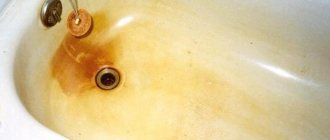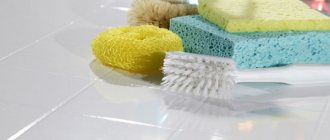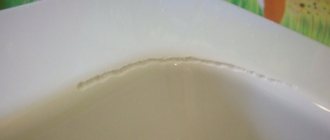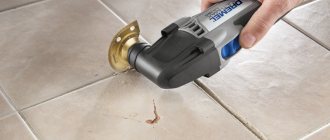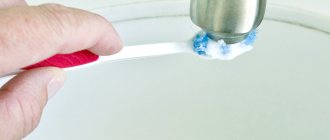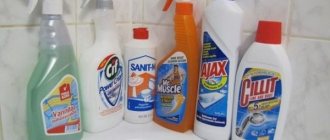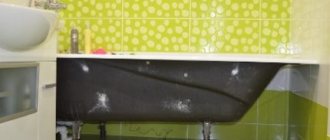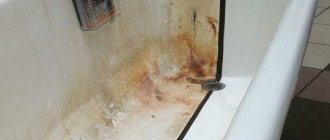Yellow stains on the bathtub not only look unsightly, but also gradually destroy its surface. Therefore, it is important to wash the bathtub from yellow deposits as soon as possible, before it turns into a persistent sediment. There are two main reasons for a yellowed bathtub:
- Poor quality water or worn out plumbing system. Impurities of rust, chlorine, and an increased concentration of hardness salts lead to the appearance of plaque or smudges on plumbing fixtures. Yellowness is formed due to constant contact of the surface with chlorinated or rusty water.
- Improper bath care. First of all, we mean the abuse of chlorine-containing household chemicals. By themselves, these products whiten plumbing fixtures well and destroy fungus, so you shouldn’t give them up completely. But everything is good in moderation. Just like chlorinated water, chlorine-based cleaning products change the color of the surface with frequent use. The bathtub turns yellow and loses its shine, becomes porous and rough to the touch.
Note. Usually the problem occurs in places where water stagnates or drains for a long time. The most vulnerable areas are the drain hole and the areas under the faucet or shower head. A malfunction of the faucet or shower hose aggravates the situation - water dripping or flowing for a long time is guaranteed to form yellow stripes on the contact areas.
Methods and means for removing yellow plaque depend on the material of the bathtub surface.
Main types of pollution
The bathtub has to be washed from various contaminants, and in order to choose the right product, you need to find out the reason. Standard bathroom stains:
- Soap scum. Shampoo, soap, shower gels, etc. are used every day. If you do not wash the bathtub thoroughly after each use, a barely noticeable film appears, which layers over and over again and turns into an unsightly coating. The film from household chemicals eats into the walls and cannot be removed without detergents.
- Lime deposits. It appears on plumbing fixtures upon contact with hard water.
- Rust. Red streaks on the bathtub will appear if there is a high concentration of iron in the water.
- Yellowness. It is caused by water flowing through old communications that can no longer be washed.
- Mold. Black spots of fungus are not only unpleasant in appearance, but also dangerous to health. They appear in the seams between the bathtub and the wall, on slopes and in other places with high humidity. It is imperative to get rid of mold, as its spores penetrate the human respiratory tract.
- Colored spots. The reason for this is careless handling of dyes: hair dye, brilliant green, potassium permanganate, etc.
- Traces of repairs. When carrying out cosmetic or major bathroom renovations, it is important to protect the plumbing. It is difficult to clean a bathtub from traces of repair.
If you want to clean your bathtub white, you should inspect it carefully. If there are cracks on the surface, then it will not be possible to completely remove the stains, and they will appear again. In cracks, contaminants accumulate and are retained. But it’s quite possible to remove yellowness and brighten the bathroom using folk methods.
Causes of yellow plaque
The presence of yellowness on the main attribute of the bathroom is not a reason to buy new plumbing fixtures. Plaque looks untidy and unsightly, and must be constantly combated. Before you start cleaning, you should find out the reasons for its appearance.
Very often the cause of yellow plaque on the bathroom is contamination of tap water.
- Poor quality of tap water.
- Rust.
- Limescale.
Attention! Yellowness does not appear in the bath in one or two days; it is a long process. Therefore, to avoid it, it is necessary to carry out regular cleaning.
How to remove rust
You can remove rust from a bath using the following methods:
- Ammonia. It needs to be applied to the bathroom for a couple of minutes, then rinsed with water. Ammonia has a pungent odor, so it is better not to close the bathroom door during treatment.
- Lemon juice. Used similarly to the previous product. Lemon juice can also be mixed with borax - this mixture will add shine to the bathroom.
- A solution of vinegar and salt. Sprinkle salt on the stain, pour vinegar over it, leave for 20 minutes, then remove with a soft cloth.
- Oxalic acid. It can be used to clean the bathtub from rusty stains. Dissolve the product in water in a 1:1 ratio and spread on the stain, leave for 20 minutes, rinse.
- Traces of rust are washed off with water, peroxide and alcohol. The last 2 components are mixed in a 2:1 ratio, applied to the stain using a sponge, leave for 15 minutes. Next, rinse with water.
Another effective cleaning solution is a mixture of soda ash and baking soda.
- Mix soda ash and baking soda in a 1:1 ratio.
- Add enough water to the baking soda mixture to obtain a porridge-like consistency, stir until smooth.
- Apply an even layer over the surface of the rust stain.
- Mix regular vinegar and powdered bleach. Proportion 1:1. Apply to a layer of baking soda.
- Leave it on for 30 minutes, then rinse off.
Important! You should not scrub off rust with a metal brush; regardless of the material from which the bathtub is made, its coating will be damaged.
Method 6: baking soda
One of the most popular products for cleaning items at home is baking soda. The product effectively removes blackness, rust and regular yellow plaque.
How to use baking soda wisely:
- Make a paste and apply evenly to areas of contamination.
- Leave for 10-15 minutes.
- Wash off with a stream of water.
Important You need to make a paste out of soda, otherwise the granules will scratch the acrylic. But even then it is forbidden to rub the product in: it will ruin the protective layer of the surface.
Lime deposits
Use soda and vinegar to remove limescale from the bathtub. Order:
- Mix baking soda and soda ash, take them in equal parts.
- When dry, sprinkle on plaque. Leave for 30 minutes.
- Rub lightly, a light abrasive will remove plaque. Then wash off.
Vinegar is used like this:
- Soak paper napkins in vinegar.
- Cover areas with deposits with napkins.
- Leave to act for 5 hours.
- After the allotted time, remove the napkins and rinse with plenty of hot water.
Lemon juice can remove yellowness from a bathtub. For one-time cleaning you will need 100 g. Dilute the juice with 2 tbsp. water, apply the solution to the dirt. Repeat the procedure for 2 hours at intervals of 15 minutes. Next, carefully rinse off any remaining residue with water. Cleaning should be done with rubber gloves, as lemon juice can damage the skin of your hands.
Stubborn old stains can be removed with ammonia and peroxide. It is necessary to mix 2 parts of ammonia and 1 part of peroxide. Apply the resulting liquid to the stain and leave for 15 minutes. Afterwards, rub the treated areas with a sponge and rinse off the surface. If the stains were not removed the first time, repeat the procedure.
Using household chemicals to remove yellow stains will be a quick solution to the problem, but you should carefully read the manufacturer’s recommendations and choose the product that suits the material of your bathroom. Bathroom tiles can also be cleaned of plaque using folk remedies.
Household chemicals
Household products will help you deal with various types of stains on a cast iron bathtub. Before purchasing them, be sure to carefully read the composition. Some components can aggravate the situation and lead to damage to the enamel surface of the plumbing fixtures.
Give preference to products that do not contain abrasive substances that are dangerous to the surface of the bathtub. Do not buy chemicals based on aggressive acids. The exceptions are lemon, oxalic and sulfamic. But they can only be used in areas where there is rust. If you use such products over the entire surface, there is a high probability of cracks appearing. Do not use household chemicals containing chlorine; they can only be used for spot treatment of areas affected by fungus.
Some components of cleaning products can damage the surface of the bathtub. Therefore, before purchasing them, carefully read the instructions.
To choose an effective and safe product, carefully read the product label. Make sure that it is designed specifically for cleaning a cast iron bathtub. It is important that household chemicals contain surfactants (surfactants) and additives that perform a disinfectant function. The presence of dyes or fragrances in the composition is safe for health and will not harm the plumbing.
When choosing household chemicals for a cast-iron bathtub, give preference to gels or creams - they can be used frequently without fear of damaging the surface. Powders are suitable for periodic cleaning. The following products are especially popular among housewives: Comet, Cillit, Cif, Amway, etc.
Mold
Black spots of fungus must be removed. Both traditional methods and household chemicals will help:
- Coal. Grind the tablets and mix with liquid bleach until a porridge-like consistency is obtained. Distribute the resulting product over the stain, leave for 1 hour and rinse.
- Soda and vinegar. To clean, sprinkle baking soda in a thick, even layer over areas with mold, then pour in vinegar and leave until the reaction is complete.
- Mold stains can be washed off with laundry soap, but this must be done regularly.
- Copper sulfate. It is dissolved in water and applied with a brush to areas with mold. This must be done with gloves.
- To clean the bathtub, household chemicals are used. A simple option is bleach or chlorine. Apply the product to the affected areas and leave for 15 minutes, then rinse with water.
Useful tips
To remove yellowness and further maintain the cleanliness of the font, it is important to remember the following useful recommendations:
After each use, rinse the bathtub with warm water, then wipe dry with a soft cloth.
- When using any plumbing product, it is advisable to wear gloves to protect your skin from irritation.
- Before removing yellow stains using household chemicals, you need to turn on the forced exhaust in the bathroom.
- The final stage of any cleansing with a special product is rinsing the bath with water and wiping dry with a napkin.
- You should not place metal cans and bottles on the sides of the bathtub, as they may leave rust marks.
- It is necessary to keep the faucet in good condition, since constantly dripping or flowing water leaves a persistent smudge.
All the most important and useful information about cleaning the bathroom is collected in this section of the site.
Acrylic bathtub
You need to carefully wash the acrylic bathtub from plaque, since acrylic is a very fragile material. Basic care is regular rinsing with warm water, this should be done after each use. Use only soft sponges and special cleaning products. You can remove accumulated dirt with a weak solution of washing powder. To clean bathtubs with acrylic coating, it is prohibited to use:
- Alkaline and acidic compounds.
- Solutions containing alcohol.
- Abrasives: powders, hard scourers, etc.
- Bleach with chlorine.
Advice! For general cleaning, purchase a special cleaning agent for acrylic in the form of a gel, cream or foam.
What can't be used and why?
To wash an acrylic bathtub, you cannot use the following products:
- Acetone. It can lead to thinning of the acrylic layer and rapid wear of the bathtub.
- Abrasive substances. This applies not only to cleaning powders, but also to regular soda. It can only be used in diluted form. The use of abrasive compounds contributes to the appearance of scratches.
- Highly concentrated acids, for example, vinegar essence.
- Paint thinners, gasoline.
- Boiling water. To prevent acrylic from cracking, the water temperature should not exceed 60 degrees.
- Chlorine and cleaning products based on it. Its use leads to the formation of pores, which reduces the service life of the product.
- Formaldehyde. These substances are not only toxic, but also completely incompatible with acrylic.
Enamel bath
The enameled steel bathtub is highly wear-resistant and easy to clean. In this case, you cannot use products containing acid and chlorine; under their influence, the enamel will turn yellow.
If a yellow coating appears, you cannot use abrasives, since the enamel layer is quite thin and can be easily damaged.
- A mixture of baking soda and water will help remove rust. Apply it to the stain and leave for 40 minutes, then wash off.
- Soda ash mixed with baking soda will help make the surface white. Removing stains and disinfecting can be done with mustard. Apply the powder for 20-30 minutes, then rinse with water.
- Salt and wine vinegar will help get rid of old stains. You need to take 1 tbsp of salt. l. and add it to 100 ml of vinegar. Afterwards, put the mixture on the stove and heat it to a temperature of 60 degrees. Next, apply the mixture to the stain and leave for 20 minutes.
- You can remove yellowness and limescale using citric acid. Dissolve 2 tbsp in a glass of water. l. lemons and apply to problem areas using a sponge or spray bottle. After 15 minutes, wipe the stains again with a sponge soaked in the solution and rinse with water.
- Cleaning powder paste. For the product you need: peroxide 60 ml, any cleaning powder (soft) 300 g, cream of tartar crystals 5 g. Mix the components and treat the contamination. Excellent fight against rust.
Special formulations
To clean an acrylic bathtub, you can use the following store-bought products:
Cinderella emulsion
This composition is intended for processing acrylic . After its use, a protective film is formed on the surface, and the bath acquires a characteristic shine. The composition is based on anionic and nonionic surfactants.
Before use, the bottle must be shaken thoroughly. To remove stubborn stains, leave the product on the surface for 10 minutes. The price of the bottle is 80 rubles.
Spray Unicum
It can be used to combat:
- rust,
- mold,
- soap and limescale deposits.
The composition is destructive to fungi, so it can be used for antiseptic treatment. The formula includes acids in acceptable concentrations and anionic surfactants.
The use of the product gives the bath its original shine and leaves behind a protective layer. Price – 200 rubles.
Sanfor gel Acrylight Professional
This gel effectively removes rust, limescale and soap deposits , and copes with unpleasant odors. Its formula is enhanced with citric acid and surfactants.
The product has an antibacterial effect. Price – 150 rubles.
The listed compositions can be purchased in retail stores, in departments with household chemicals, as well as in online markets.
Video about using the Sanelit cleaning product for cleaning acrylic bathtubs:
Cast iron bath
If you want to clean your cast iron bathtub white, it is important to know what substances you should not use. Prohibited:
- Petrol
- Washing powder
- Chlorine
- Strong acids
- Abrasive pastes
- Metal, fiberglass sponges
Advice! Cleaning agents for heavy stains can be white spirit or acetone.
Allowed to use:
- Soda ash, baking soda.
- Vinegar and lemon juice or acid. These components should not be applied more than once a week.
- Ammonia.
The methods for using all these tools are described above.
How to clean an old cast iron bathtub
It is possible to wash an old cast-iron bathtub, but over time you will have to fight with more radical means. The most common problem with old cast iron bathtubs is yellow stains. They appear as a result of the reaction of water with zirconium salts, which are found in old baths.
Vinegar essence will help remove yellowness from a very dirty bathtub. How to use:
- Fill a bath full of warm water.
- Pour in 1 glass of vinegar essence.
- Leave for 4 hours, then drain the water and rinse the bathtub with water.
It is better not to use bleach to remove stains from cast iron bathtubs ; instead, we will offer several more cleaning options:
- Mix baking soda with liquid soap until a homogeneous paste is obtained. Rub on traces of rust, stains, leave for 20 minutes, then rinse.
- Ammonia and any liquid soap. You need 1 tbsp of ammonia. l, liquid soap 0.5 tbsp. Combine the components and apply the resulting solution to the stain. Leave for 15 minutes, rub thoroughly with a soft sponge, rinse. After such cleaning, the bath will shine again.
Jacuzzi cleaning rules
Whirlpool baths require a careful and responsible approach. It differs from standard models in the presence of nozzles through which the pump supplies directed water jets. Irregular use of the Jacuzzi leads to the formation of limescale and pathogenic microflora on the outlets. The cleansing rules are as follows:
- Fill the bathtub with hot water 6–8 cm above the level of the nozzles.
- Disable air massage, if present.
- Pour in a special cleaning composition. Dishwasher safe. To get the result, 50 ml is enough. For bactericidal treatment, use 150–200 ml of vinegar.
- Run the hydromassage equipment for 15–20 minutes. This technique allows you to remove dirt accumulated inside the injectors - it easily flows out.
- Drain the dirty water and refill the bath. Restart the hydromassage.
At the final stage, clean water will wash the insides of the nozzles. The bathtub is ready for safe use again.
It is not recommended to add chloride compounds as disinfection. They not only damage plastic, but also corrode silicone and rubber gaskets.
How to clean a bathtub after renovation
During renovation, it is important to protect the bathroom with film from the ingress of construction mixtures and paint. It is quite difficult to clean the bathroom from these substances without damaging the surface. Try to remove stains while they are fresh.
Important Recommendations:
- To remove streaks of paint or sealant, use a solvent: acetone or white spirit.
- If the silicone, paint or mortar has already dried, then the first stage of removal is mechanical cleaning. To do this, use a razor blade, which carefully cuts off ball by ball, without touching the surface of the bathtub. After this, a cloth soaked in a solvent is applied to the stain. You need to leave it for 15 minutes. There is a chance that the coating will come off along with the stain, so it will have to be renewed.
- It is difficult to remove traces of repair from acrylic bathtubs: sanding is required.
- Table salt will also help with cleaning, but it is better to purchase specialized products.
Method 2: Pemolux gel
It is not recommended to clean acrylic with ordinary Pemolux powder, since it contains hard granules. But the gel from this series is great for acrylic.
Cleaning steps:
- A little gel is applied to the dirty area.
- After some time, remove with a sponge, wash with clean water and wipe with dry cotton cloth.
Bathroom care rules
To protect your bathtub from plaque, stains and scratches, follow these recommendations:
- Do not leave the position of the faucet the same so that the water flow is not directed to one point.
- Dripping faucets should be repaired promptly.
- Make sure that the bathtub is installed correctly; no water should remain in it after draining. If this happens, the bathtub needs to be leveled or moisture removed after each use.
- Ventilate the bathroom to get rid of excess moisture.
- Do not use too aggressive products; regular dish detergent or the above stain removal options are sufficient. Contaminants stick to chemically damaged surfaces much faster.
- Powders are used for bathtubs made of steel and cast iron, gels for acrylic ones.
- Regular care is the solution to many cleaning difficulties. It is recommended to wash the bathtub with laundry soap and a soft washcloth.
- The bathtub bowl should not undergo sudden temperature changes, as this may cause cracks to form.
- Buckets and basins that are placed in the bathroom must be plastic.
